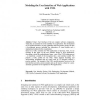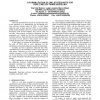103
Voted
UML
2001
Springer
15 years 4 months ago
2001
Springer
Sequence Diagrams (SDs) have proven useful for describing transaction-oriented systems, and can form a basis for creating statecharts. However, distributed embedded systems require...
116
click to vote
UML
2001
Springer
15 years 4 months ago
2001
Springer
Today's User Interfaces (UIs) are complex software components, which play an essential role in the usability of an application. The development of UIs requires therefore, not ...
120
click to vote
UML
2001
Springer
15 years 4 months ago
2001
Springer
Modern distributed software applications generally operate in complex and heterogeneous computing environments (like the World Wide Web). Different paradigms (client-server, mobili...
121
click to vote
UML
2001
Springer
15 years 4 months ago
2001
Springer
: There are many different ways to specify the requirements of complex software systems, and the optimal methods often vary according to the problem domain. We apply and compare tw...
UML
2001
Springer
15 years 4 months ago
2001
Springer
: There are several reasons to specify UML models in a formal way The most important are to avoid inconsistencies and ambiguities and to do verification and forecasting of system p...
77
Voted
UML
2001
Springer
15 years 4 months ago
2001
Springer
We present a real-time execution semantics for UML activity graphs that is intended for workflow modelling. The semantics is defined in terms of execution algorithms that define...
105
click to vote
UML
2001
Springer
15 years 4 months ago
2001
Springer
: This paper introduces the Calculating with Concepts (CC) technique, which has been developed to improve the precision of UML class diagrams and allows the formal reasoning based ...
127
Voted
UML
2001
Springer
15 years 4 months ago
2001
Springer
The work presented here is part of a project that aims at the definition of a methodology for developing realtime software systems based on UML. In fact, being relatively easy to ...
81
Voted
UML
2001
Springer
15 years 4 months ago
2001
Springer
: This paper presents a Unified Modeling Language (UML) model for VisualAge Generator (VG) business-oriented applications. This model was defined to bridge between two different mo...
92
Voted
UML
2001
Springer
15 years 4 months ago
2001
Springer
Abstract. As the UML attempts to make the transition from a single, albeit extensible, language to a framework for a family of languages, the nature and form of the underlying meta...


